Brooke Community Mourns Its School
By Samantha Hall
Photography By Milly Orellana
Reporting Texas TV
There was nothing unusual about this year’s Brooke Elementary School Valentine’s dance at first glance. The “Roaring ‘20s” themed celebration was held in the school’s cafeteria. The decorations evoked the themes and aesthetic of The Great Gatsby.
Were it not for the white tablecloth-covered booth set up near the cafeteria’s entrance, it would have appeared to be a regular elementary dance. The booth, with signs in both English and
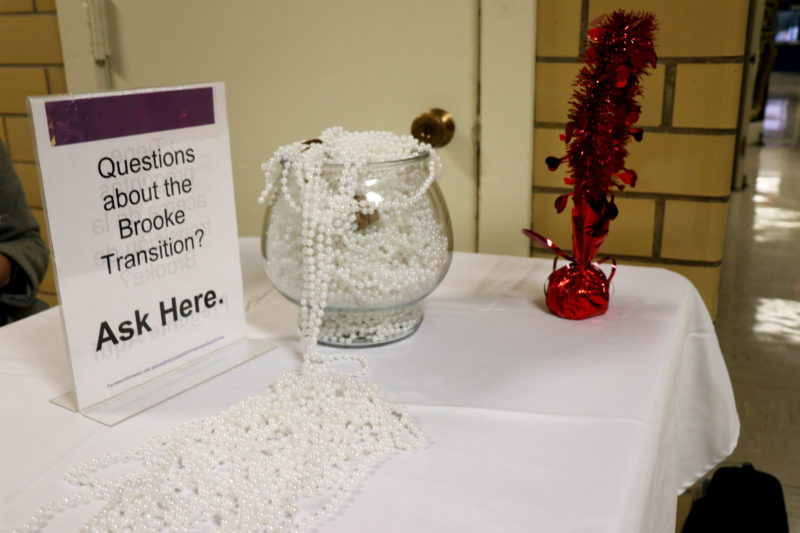 Spanish, was manned by two Austin school district staffers who were present to answer any questions parents may have about their kids’ future.
Spanish, was manned by two Austin school district staffers who were present to answer any questions parents may have about their kids’ future.
It was Brooke’s last Valentine’s dance. Brooke will close its doors permanently at the end of the school year.
“It’s been really hard,” Brooke principal Griselda Galindo-Vargas said. “As a principal, you build a vision, and it’s almost like ‘I built this, and now you’re telling me it’s not enough.’”
Last November, the Austin Independent School District board voted 6-3 in favor of closing four schools. Among them was East Austin’s Brooke Elementary.
Brooke parents and teachers are not optimistic for their futures, despite the positive and encouraging sentiment the district has presented. PTA President Jessica Wilson explained that finding a new school is more than picking the school that’s closest. One school may technically be closer than another, for example, but it’s in the opposite direction of work. Other students rely on either being able to walk to and from school or taking the bus.
But this brings its own problems. For instance, some students are close enough to their potential new schools to walk, but the pathway there is unsafe for them to do so, Wilson said. If the school is close enough to walk, then it’s too close for there to be a bus for the students to take, which means they have to be driven. But not every family has more than one car, or even has a car at all. No matter which school the students end up attending, the outcome is the same: the Brooke community is being spread apart.
This isn’t the first time some students have moved around schools either. Wilson’s daughter will have attended four different schools when school starts in the fall.
“We’re very nervous, if we go to Zavala (Elementary School) and they close that, then we’re at five schools,” Wilson said.
This fear is not exclusive to Wilson, and a lack of trust for AISD has spread throughout the community of Brooke parents, teachers and staff. They change from one moment to the next, said parent-support specialist Gloria Vera-Bedolla. As the parent-support specialist, Vera-Bedolla works to keep parents involved and engaged with their child’s education
Galindo-Vargas, Vera-Bedolla and Wilson all described the joy and relief that came from the campus’ Back to School Night celebration last September, the start of a promising new school year. That night, Brooke announced they had increased their enrollment and improved test scores to the point of becoming a recognized school. It was their understanding that they had saved the school from being considered for closure.
Later that night, however, they learned otherwise. They were told the school was on the list of possible closures. Wilson said her kindergarten daughter broke down when she heard the news. She wanted to know where her teachers and friends and the rabbits on the campus were going.
This sentiment is shared by the teachers as well, according to Galindo-Vargas. As the end of the school year gets closer, teachers are becoming more stressed. While AISD says “staff will not lose employment,” Galindo-Vargas said it’s not quite that simple.
“There’s roadblocks. If you have your resume, if you’re in good standing, if you have a quadrant in the district that you want to work in and if there’s an opening in that school (and) if the children go to the school that we designated…there’s a lot of ‘ifs,’” Galindo-Vargas said. “So if all these ‘ifs’ are lined up just nicely and the stars are aligned, then you’ll get the job that you want.”
The uncertainty has led teachers to put off making major life decisions out of fear of losing their jobs. One Brooke teacher put off having a baby because she wasn’t sure what her future would look like.
“We’re not just closing the school, we’re changing the quality of life for people,” Galindo-Vargas said she’s conveyed to the district.
The district has been holding resume-building workshops to help teachers stand out in the crowded field. The district has told teachers not to let this situation affect their classroom performance.
Testing season is approaching rapidly as well, adding to the burden. But many teachers and staff are equally, if not more so, worried about the students.
“There’s been a surge, it seems like, in behavior issues,” Vera-Bedolla said.
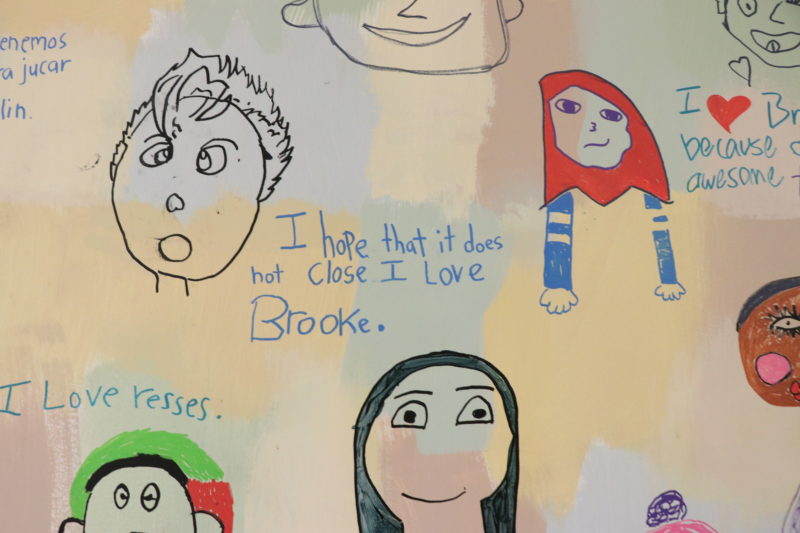 A mural located outside of the cafeteria, created by Raasin McIntosh along with the help of students at Brooke.
A mural located outside of the cafeteria, created by Raasin McIntosh along with the help of students at Brooke.
For most of the students at Brooke, it’s more than a place to learn. Galindo-Vargas and her staff have worked hard to create a safe space and community for the students to call their second home. For some students, the school is the safest place they have to go to.
Brooke Elementary has a disproportionate number of students living under economically disadvantaged circumstances. According to Vera-Bedolla, some of the students, for instance, live in their cars. For these students, Brooke is an essential component to their well-being.
The community Brooke built did not happen overnight. It took years of effort. Galindo-Vargas greets students with a hug as they enter the building each day. Wilson said her daughter gets about 2-3 hugs before she gets to her classroom. Building trust and making students feel safe is non-negotiable at Brooke.
The Brooke community has also benefited from programs designed to remedy issues unique to the students, and they must now mourn the loss of this as well. Living in a city, many of the Brooke students don’t get an opportunity to spend time out in nature. For some, there is no greenery at their apartments. For others, it’s not safe for them to go outside or to the park. Brooke has a vast outdoor infrastructure to remedy this.
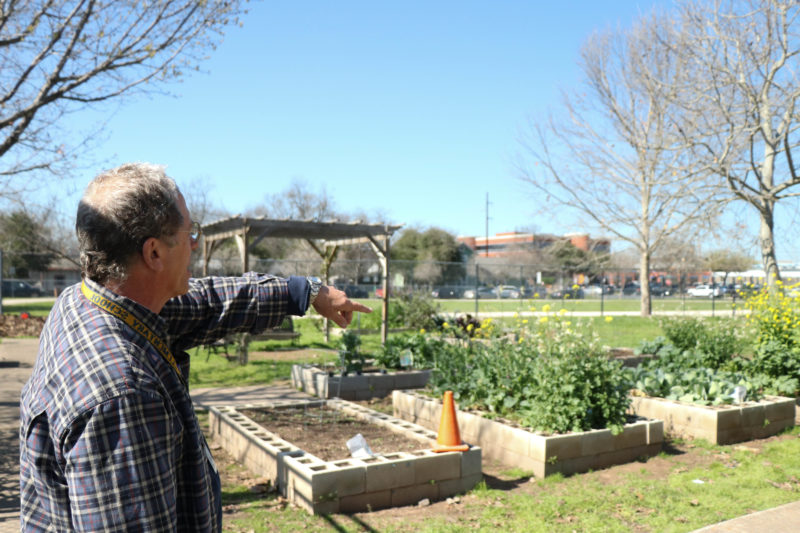 Sam DeSanto, a life skills teacher, explores Brooke’s garden.
Sam DeSanto, a life skills teacher, explores Brooke’s garden.
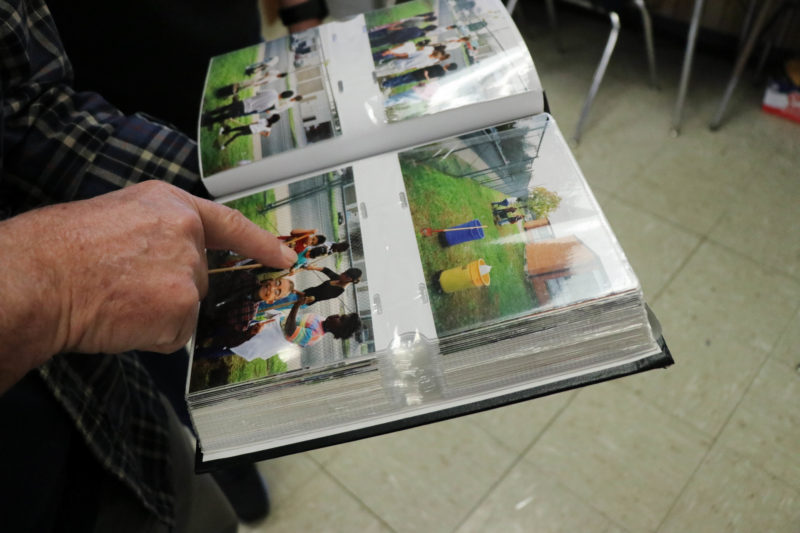 DeSanto reminisces on former students.
DeSanto reminisces on former students.
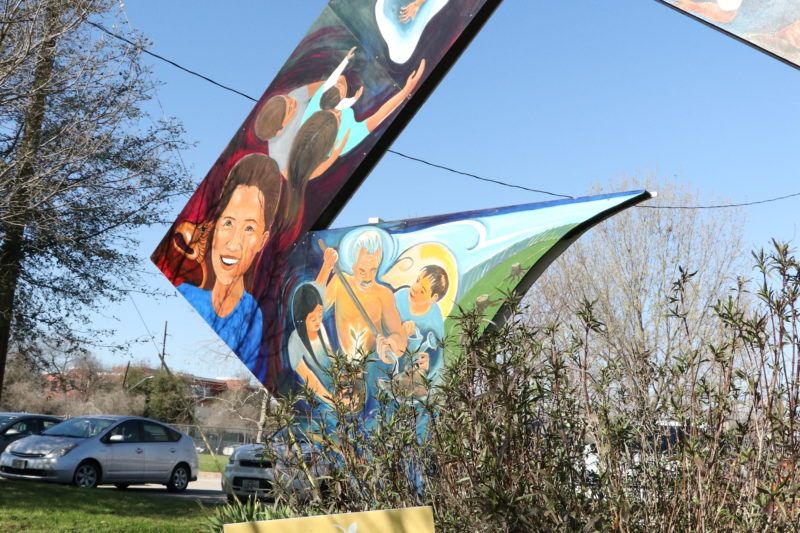 The garden has grown over the years due to contributions from teachers, parents and members of the community.
The garden has grown over the years due to contributions from teachers, parents and members of the community.
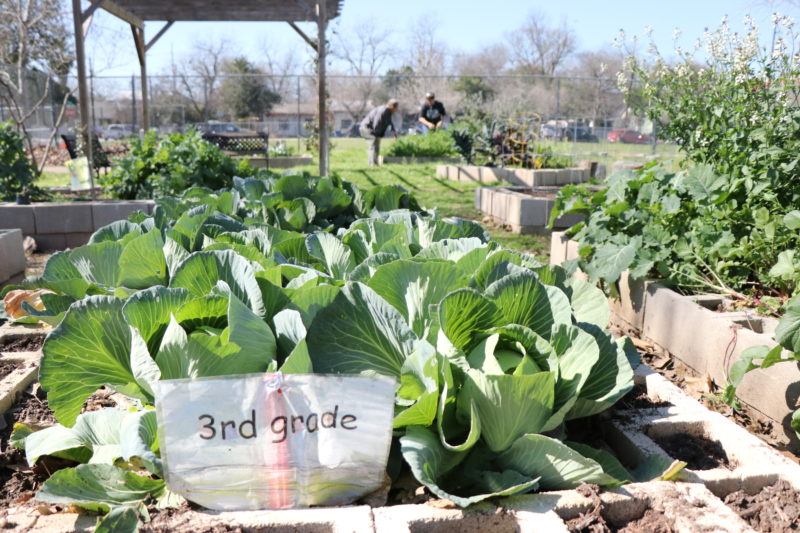 Vegetables grown at Brooke include cilantro, spinach and kale.
Vegetables grown at Brooke include cilantro, spinach and kale.
The green space surrounding the elementary school was largely implemented under the guidance of Brooke Elementary Life Skills teacher Sam DeSanto, who has been with Brooke since 1999. When he first started, all Brooke had outside was grass.
Together over time, DeSanto and Brooke students have planted trees, flowers, vegetables and other greenery to bring the outdoor space to life. Brooke has a vegetable garden, a chicken coop and even does beekeeping. They are recognized by the National Wildlife Federation’s Eco-Schools USA’s Green Flag Award—the highest honor of Eco-Schools USA. Brooke is the sixth Texas school to receive it.
Around 20 years have passed since this outdoor revitalization started. DeSanto knows the name of nearly every tree and plant on the property and who put it there. He recalls when the now full trees were small, skinny sticks many years ago. The campus over time has grown an impressive outdoor space.
“It just worked, and the kids loved it and it really was a healthy thing for everybody involved.” DeSanto said. “We just kept snowballing it.”
WATCH: The growth of Brooke’s school garden (Video by Milly Orellana)
While the exterior of the school catches the eye with its greenery, inside the school the walls are adorned with murals. DeSanto knows the stories behind several of these murals as well. One, a map of Brooke’s trees, was made by his wife. It, among other artwork, hangs proudly on the school walls.
Outside the cafeteria hangs another art piece. Across the piece are statements from various students about the school. One, for instance, says “I love [recess].” Another states, “I hope that it does not close I love Brooke.”
The school has older yearbook photos on its walls as well. On one, Kasey Felter, DeSanto’s teaching assistant, was able to point out both herself and her son. Her son, who is now a high school senior, attended school at Brooke.
“My son started Pre-K here, all the way up until fifth grade,” Felter said.” He loved it, he has great memories about it and I love Brooke. I wouldn’t send my kid here if Brooke was not important to me and to him.”
Morale at the school is low, Galindo-Vargas said. While the AISD school board voted on a two year moratorium to decide what will be done with the facility, the staff is not hopeful. Both Felter and DeSanto echoed the statement “it’s all going to be destroyed” several times.
The “what does it matter” mindset has appeared in various forms as well. The school used to have a Garden to Café program in place for the food grown on the campus, but they have ended the program, feeling it no longer mattered given the inevitable closure. Vera-Bedolla said her daughter, who loves school, has told her on three different occasions that she doesn’t want to go to school.
“Morale is tanked,” Vera-Bedolla said. “Everyone feels like we’re moving on.”
Vera-Bedolla said she worries about the many students at Brooke with behavior issues. She worries what will happen to them if they aren’t placed in an understanding environment.
“I find it highly offensive that they’ve decided to close the school because I feel that it targets…people of poverty,” Vera-Bedolla said.
The Brooke community feels defenseless, Vera-Bedolla said. The school is 84.8% Hispanic, 91% economically disadvantaged and 36% English language learners. They have students who have experienced different levels of abuse and students who are homeless. Many community members say they felt helpless during the closure-decision process.
Research shows that schools with a majority African-American and/or Latino population are closed more frequently than schools with similar academic standings that are majority white. It has also been shown that closing schools that have become a beacon for the community leaves an impact on everyone involved.
The district’s reasoning for school consolidations, according to AISD Community Engagement Coordinator Ali Ghilarducci, is to redistribute resources to better serve the students. Resources, such as counselors, are placed in schools based on population. Depending on the population of a school, they may be allowed a part-time counselor or a full-time counselor, for instance.
Research does not support this position, however. It has been shown that the best academic outcome one should expect for students after school closures is a neutral one.
Galindo-Vargas said she believes the district didn’t look very far ahead. AISD, however, is moving forward as planned.
“It’s my second home,” Felter said. “I’m going to cry when this is no longer here.”